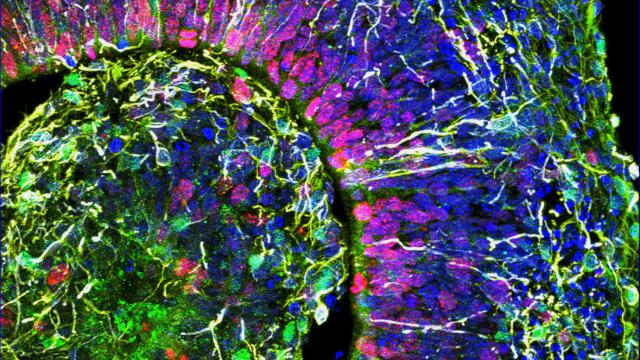One way that scientists can non-invasively study the human brain is by growing “mini-brains,” clusters of brain cells each about the size of a pea, in the lab. In a fascinating progression of this line of research, a team this week reports that they observed human-like brainwaves from these organoids.
Previous studies of mini-brains have demonstrated movement and nerve tract development, but the new study from researchers at the University of California San Diego, led by biologist Alysson Muotri, is the first to record human-like neural activity.
In their paper, published in Cell Stem Cell on Thursday, the researchers write that they observed brain wave patterns resembling those of a developing human. This sophistication in the in vitro model is a step to enable scientists to use mini-brains to study brain development, model diseases, and learn about the evolution of brains, according to Muotri.
“We are good [at studying] cancer, we are good [at studying] the heart,” Muotri told Gizmodo by phone. “But the brain has been lagging behind.”
To create these mini-brains, technically called organoids, the researchers took pluripotent human stem cells and introduced them to a nutrient-rich petri-dish designed to mimic the environment in which our own brains develop.
Due to the pluripotent nature of the stem cells — meaning they have the potential to become any number of different cells — these cells could be prodded into developing a 3D structure reminiscent of a developing human brain, although much smaller. At around two months of development, the team began to notice spikes of neural activity from the network that hadn’t been previously observed.
When the team began to observe these intermittent bursts of electrical activity, they weren’t initially looking for similarities between their model and human infants, co-author and PhD student Richard Gao told Gizmodo in an email.
“We saw that a prominent feature of these organoid oscillations is that they come in bursts: the network is inactive most of the time, and every 10-20 seconds or so, a bout of activity would spontaneously occur,” Gao said. “It was reminiscent of a feature in preterm infants, called trace discontinu, where the infant’s EEG is very inactive most of the time, punctuated by strong oscillatory transients. So if you had to call it a specific feature, I guess it’d be the fact that the oscillations come and go.… We were really fortunate at that point to find a dataset reporting these features in the preterm infant EEG.”
The team trained a machine learning algorithm to recognise prominent features in the preterm infant EEGs and had it evaluate the cerebral organoids for similarities. The algorithm was able to predict how many weeks the organoids had developed in the culture, and at between 25 and 40 weeks of the organoid’s development, the algorithm could no longer differentiate between the organoids and the infant EEGs, Muotri told Gizmodo.
But, Muotri clarified, this comparison between the two was not necessarily one-to-one. There are certain features and limitations of preterm infant EEGs, including the effects the thickness of a developing human skull has on readings, that differ from the lab-grown organoids. For the purpose of their study, Muotri says the team left out these non-comparable variables.
To really solidify these results, however, researchers say these discrepancies between the infant EEGs and the organoid will need to be reconciled.
“I think it is not possible to say how similar the organoid activity is to preterm EEG,” Arnold Kriegstein, a neurologist from the University of California, San Francisco, who did not contribute to the new study, told Gizmodo in an email. “The development of spontaneous activity in organoids is quite interesting and the investigators have convincingly shown this to be dependent on neuronal activity.
But, organoids are so different from actual developing cortex that even if the phenomenology is similar, we still need better evidence that the underlying mechanisms are the same… It’s like comparing apples to oranges: even though they are both fruit, they are not the same.”
Nevertheless, Kriegstein does say that this research is an important step toward answering those questions.
Another question that this experiment and others like it raise, said Muotri, is whether or not mini-brains can be considered conscious and what ethical dilemmas might ensue in the future. While Kriegstein contended that the organoids were not developed enough to be considered conscious, Muotri said he can’t be sure either way.
“My original answer was to say ‘I don’t think so,’ but the truth is we have no evidence either way,” Muotri told Gizmodo. “We don’t yet have methods to test that.”
To approach this question, Muotri plans to hold a meeting at UC San Diego this October with scientists, philosophers, and ethicists to discuss the ethical future of such technologies.
“My tendency is always to say as with any other technology, take blood transfusions or organ transplants, or even regular cars,” Muotri said. “These are all technologies that can be used for good and bad, but we as a society, we see the good and bad… And I think brain organoids will be in the same direction.”
